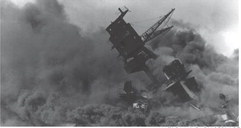Remembering legacy of Pearl Harbor attack


On Dec. 7, 1941, Japan launched a surprise attack on the U.S. Pacific Fleet at Pearl Harbor, Hawaii. The assault killed or wounded more than 3,500 American troops and civilians; se...


On Dec. 7, 1941, Japan launched a surprise attack on the U.S. Pacific Fleet at Pearl Harbor, Hawaii. The assault killed or wounded more than 3,500 American troops and civilians; se...